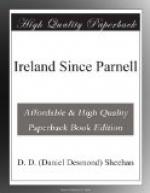The movement was publicly inaugurated at a meeting held in the Rotunda, Dublin, on 25th November 1913, the leading spirits in the organisation being Captain White, D.S.O., and Sir Roger Casement, a Northern Protestant who, knighted by England for his consular and diplomatic services, was later to meet the death penalty at her hands for his loyalty to his own country. The new body drew its supporters from Parliamentarians, Sinn Feiners, Republicans and every other class of Irish Nationalist. The manifesto it issued stated: “The object proposed for the Irish Volunteers is to secure and maintain the rights and liberties common to all the people of Ireland. Their duties will be defensive and protective and they will not attempt either aggression or domination. Their ranks are open to all able-bodied Irishmen without distinction of creed, politics, or social grade.” And then it appealed “in the name of national unity, of national dignity, of national and individual liberty, of manly citizenship to our countrymen to recognise and accept without hesitation the opportunity that has been granted to them to join the ranks of the Irish Volunteers and to make the movement now begun not unworthy of the historic title which it has adopted.” The president of the Volunteers was Professor John MacNeill, who had borne an honourable and distinguished part in the Gaelic League Revival. They declared they had nothing to fear from the Ulster Volunteers nor the Ulster Volunteers from them. They acknowledged that the Northern body had opened the way for a National Volunteer movement, but whilst at first they were willing to cheer Sir Edward Carson because he had shown them the way to arm, it was not long before they recognised that whilst extending courtesy to Ulster, their supreme duty was the defence of Irish liberty. For this they drilled and armed in quiet but firm determination. When Partition became part of the policy of the Irish Party, Mr Redmond and his friends had many warnings that the Irish Volunteers were not in existence to support the mutilation of Ireland. They proclaimed their intention originally of placing themselves at the disposal of an Irish Parliament, but not of the kind contemplated by the Home Rule Bill. The Irish Party saw in the Volunteers a formidable menace to their power, if not to their continued existence. They must either control them or suppress them. Mr Redmond demanded the right to nominate a committee of twenty-five “true-blue” supporters of his own policy. The Volunteer Committee had either to declare war on Mr Redmond or submit to his demand. They submitted. The Government, who were supposed to have instigated and inspired Mr Redmond’s demand, were satisfied. The reconstituted Committee called the new body the National Volunteers.
But though the Redmondites got control of the Committee they did not succeed in curbing the spirit of the Volunteers. And besides there was in Dublin an independent body of Volunteers entitled the Citizen Army, under the control of Messrs Connolly and Larkin. This was purely drawn from the workers of the metropolis and was fiercely antagonistic to the Ancient Order of Hibernians, which The Irish Worker declared to be “the foulest growth that ever cursed this land,” and again as “a gang of place-hunters and political thugs.”




